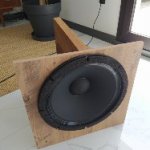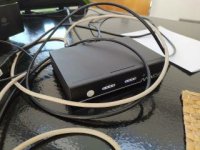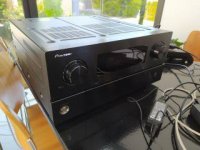I moved countries and bought a new house to build a dedicated listening room and large OB speaker. That was almost three years ago. Finally getting on with it.
First the modular woofer unit.
One GPA 416-8B per side.
50x50cm baffle.
And large and heavy fin against vibrations.
One GPA 416-8B per side.
50x50cm baffle.
And large and heavy fin against vibrations.
Attachments
Last edited:
variation 1
two way with BG neo8s
crossover @ 600hz LR4
grey thingies are acoustic foam wedges (bass traps)
i have tried h u w n frames, you name it
and there is always a cavity resonance no matter what crossover
my solution is to build the cavity out of acoustic foam
result, good bass extension and no resonances
kind of similar to OllBoll's idea
Dipole wool carpet baffle experiment
two way with BG neo8s
crossover @ 600hz LR4
grey thingies are acoustic foam wedges (bass traps)
i have tried h u w n frames, you name it
and there is always a cavity resonance no matter what crossover
my solution is to build the cavity out of acoustic foam
result, good bass extension and no resonances
kind of similar to OllBoll's idea
Dipole wool carpet baffle experiment
Attachments
Last edited:
variation 1 sounds okay
but the two drivers do not blend seamlessy
i could try LR2 or a lower CO point
but i do not want to stress the planar unit
any comments on variation 1?
a 3 way variation next
but the two drivers do not blend seamlessy
i could try LR2 or a lower CO point
but i do not want to stress the planar unit
any comments on variation 1?
a 3 way variation next
That large thick vertical brace in the back holding the baffle up is a huge problem. The first thing to do is to get rid of it.
That large thick vertical brace in the back holding the baffle up is a huge problem. The first thing to do is to get rid of it.
hi,
why do you think the brace is a huge problem?
these are prototypes. i might build a heavy baffle and get rid of the brace in the final build.
I'm not crazy about the big brace at the back. I dunno if it's the current price of wood or the acoustic effects, but something tells me there is a more elegant solution to be had. Wings on the sides are good, but right down the middle, may be more problems than solutions.
I regard to the Neo8, do you find it plays all the way up and down nicely? And where have you tried crossing the Neo8? I've seen a dual Neo8 horn design from Joseph Crowe that used these down to 250hz IIRC but that was with horn loading. I've heard others use the Neo 8 from closer to 1000hz up. That GPA should have no issues tho with that, eh?
I would look at other projects where folk have used the Neo8 with success. I seem to recall some using then with Neo3 tweeters etc. The Crowe horn was the first time I saw them used so low.
It sounds like you're only running a single order crossover with a cap or something on it? Or is the DSP doing everything? I would think that single order crossovers are a bit of black magic, and in the days of production made a lot of sense. Some got them to sound great and they still can, but I don't think it's a general principle we can apply to any 2 drivers and expect them to work well. The drivers that did work in those situations are usually pretty unique or have characteristics that lend well to a 1st order XO. Taking it to an LR2 or higher order will definitely help that Neo8.
The baffle-less design is going to limit low end extension on your driver's without much baffle to work with. The sound travels like 2" before the rear wave interferes. I found that a lot of what a driver advertises is mitigated once a baffle or enclosure are out of the picture. The response of the driver sounds nice on paper, but you won't get that moving to open baffle. Not all of it anyways.
Baffle shapes and designs are half the fun in experimenting with OB in my opinion. The beauty of the Neo8 is its size and shape.. . Experimentation isn't going to be super hard if you feel adventurous. I would try maybe taking the XO slope to a higher order, and maybe trying a few different baffle ideas, maybe a bigger bass baffle.
In regard to resonances it reminds me of my Goldwood 1858 HFrames. I didn't realize that MJK used the rising response created by the cavity to get his crossover to blend nicely. He had to account for it by crossing LR2 125hz (IIRC) but acoustically this meant flat to almost 200hz before dropping off! Until I factored this into the crossover, my HFrames sounded like farty poop voice inside em. Once I got an active XO and could crossover steeply and low enough to avoid that resonance, it was much nicer.
I regard to the Neo8, do you find it plays all the way up and down nicely? And where have you tried crossing the Neo8? I've seen a dual Neo8 horn design from Joseph Crowe that used these down to 250hz IIRC but that was with horn loading. I've heard others use the Neo 8 from closer to 1000hz up. That GPA should have no issues tho with that, eh?
I would look at other projects where folk have used the Neo8 with success. I seem to recall some using then with Neo3 tweeters etc. The Crowe horn was the first time I saw them used so low.
It sounds like you're only running a single order crossover with a cap or something on it? Or is the DSP doing everything? I would think that single order crossovers are a bit of black magic, and in the days of production made a lot of sense. Some got them to sound great and they still can, but I don't think it's a general principle we can apply to any 2 drivers and expect them to work well. The drivers that did work in those situations are usually pretty unique or have characteristics that lend well to a 1st order XO. Taking it to an LR2 or higher order will definitely help that Neo8.
The baffle-less design is going to limit low end extension on your driver's without much baffle to work with. The sound travels like 2" before the rear wave interferes. I found that a lot of what a driver advertises is mitigated once a baffle or enclosure are out of the picture. The response of the driver sounds nice on paper, but you won't get that moving to open baffle. Not all of it anyways.
Baffle shapes and designs are half the fun in experimenting with OB in my opinion. The beauty of the Neo8 is its size and shape.. . Experimentation isn't going to be super hard if you feel adventurous. I would try maybe taking the XO slope to a higher order, and maybe trying a few different baffle ideas, maybe a bigger bass baffle.
In regard to resonances it reminds me of my Goldwood 1858 HFrames. I didn't realize that MJK used the rising response created by the cavity to get his crossover to blend nicely. He had to account for it by crossing LR2 125hz (IIRC) but acoustically this meant flat to almost 200hz before dropping off! Until I factored this into the crossover, my HFrames sounded like farty poop voice inside em. Once I got an active XO and could crossover steeply and low enough to avoid that resonance, it was much nicer.
Last edited:
i did build variation 2 and 3, but have been going back to variation 1 for comparison.
so a few more notes before moving on;
15" GPA does have its own sound signature; you may call it coloration.
human voices are noticeably thicker and instruments like piano have a fuller body, more resonant nature.
initially this is quite enjoyable (richer, more energetic?).
but, esp with a-b comparison, i can tell that it is unnatural.
why?
perhaps because of the heavy cone (although 416-8b is one of the lightest among 15").
or the unavoidable deep cone shape, or the voice coil cavity.
in any case, i decided not to use the 15" above 200-300hz.
so a few more notes before moving on;
15" GPA does have its own sound signature; you may call it coloration.
human voices are noticeably thicker and instruments like piano have a fuller body, more resonant nature.
initially this is quite enjoyable (richer, more energetic?).
but, esp with a-b comparison, i can tell that it is unnatural.
why?
perhaps because of the heavy cone (although 416-8b is one of the lightest among 15").
or the unavoidable deep cone shape, or the voice coil cavity.
in any case, i decided not to use the 15" above 200-300hz.
Last edited:
damn wood prices indeed 🙂
i bought that butcher block long time ago.
a heavy midline brace is the best stabilizer for flat OBs, imo
and it should be acoustically ok esp for the woofer because of the larger wavelengths down there.
i will address the rest in my upcoming posts.
i bought that butcher block long time ago.
a heavy midline brace is the best stabilizer for flat OBs, imo
and it should be acoustically ok esp for the woofer because of the larger wavelengths down there.
i will address the rest in my upcoming posts.
Was looking at that brace arrangement in ripple tank. Looks like it may delay the rear wave a bit. So the side nulls aren't as prominent. Looks to also attenuate the front wall interaction as well. A little. You may be on to something here.
second note on variation 1
neo8s seems to be doing alright crossed LR12 or 24db at 600hz, although i would be really hesitant to cross it any lower.
neo8s seems to be doing alright crossed LR12 or 24db at 600hz, although i would be really hesitant to cross it any lower.
third and final note is on bass
unless you are not using very high excursion woofers, a steep high-pass filter is a must to stop max out on OB. as such i advice strongly against attempting OB with passive filters.
416-8b bottoms out easily with bass heavy music at regular listening level. its xmax is about 4mm. LR48db high-pass at 50hz gets rid of maxing out... any lower filter and you start getting problems. when the woofer bottoms out it starts sounding like a blown woofer; lots of unhappy noises.
i also have the faital pro 18hf500 (xmax 9mm) and it required high-pass at 40hz.
i am using mild 6db EQ correction for dipole peak/loss on the woofer.
even with steep high-pass at 50hz the bass is fantastic... ABSO*LUTELY FANTASTIC!
unless you are not using very high excursion woofers, a steep high-pass filter is a must to stop max out on OB. as such i advice strongly against attempting OB with passive filters.
416-8b bottoms out easily with bass heavy music at regular listening level. its xmax is about 4mm. LR48db high-pass at 50hz gets rid of maxing out... any lower filter and you start getting problems. when the woofer bottoms out it starts sounding like a blown woofer; lots of unhappy noises.
i also have the faital pro 18hf500 (xmax 9mm) and it required high-pass at 40hz.
i am using mild 6db EQ correction for dipole peak/loss on the woofer.
even with steep high-pass at 50hz the bass is fantastic... ABSO*LUTELY FANTASTIC!
That's why I was using eight 18" woofers in my OB system more than 15 years ago when I had the space for such a big system. No worry about bottoming out the woofers. 🙂
That's why I was using eight 18" woofers in my OB system more than 15 years ago when I had the space for such a big system. No worry about bottoming out the woofers. 🙂
This is the way...
But for smaller rooms a compromise is necessary, using a powered sealed subwoofer is a more rational approach to achieving the very lowest frequencies.
C.M
C.M
- Home
- Loudspeakers
- Multi-Way
- Variations on a new OB project



![IMG_20210508_084634[1].jpg](/community/data/attachments/870/870964-0ebb2e89809ad8396f088a27d08310ef.jpg?hash=DrsuiYCa2D)
![IMG_20210508_084700[1].jpg](/community/data/attachments/870/870983-ee0b090fa96cd904f376526b15443e95.jpg?hash=7gsJD6ls2Q)